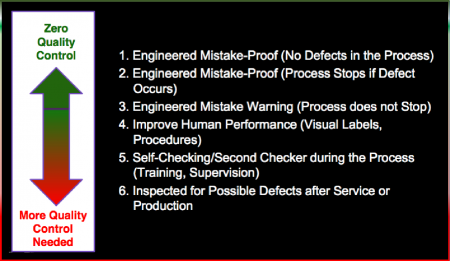You followed your procedure as written, but still made a defect!

Many forget that procedures were put in place to prevent a loss of control of a process, or if a regulatory driven requirement to use a procedure, a perceived risk of loss of control of the process. With that concept in mind, we can see in the image above that procedures are a lower and less reliable control in the mistake-proofing hierarchy and that it requires more external quality control assessments and observations.
But this article is not about how much quality control is needed to ensure that workers use a procedure as written to prevent mistakes. Instead, this article is about when workers make a mistake when they followed the mistake-proofing procedure as written. If a procedure is already at a weak level of control, how is it that an issue with writing of, auditing of or use of an ineffective procedure was allowed to exist?
To clarify how TapRooT® Root Cause Analysis defines a procedure, we look at the intent of how it is used and not necessarily what it is called. If a list of steps on how to perform a task is written down and must be read and followed while performing the task, it is a procedure to TapRooT®. For example,
- A metal placard on how to set up the lathe that you require the operator to read every time for set up is a procedure.
- The SOP for putting on your seatbelt listed in the car manual that you only reference occasionally to successfully put your seatbelt on is NOT a procedure.
Not every task needs a procedure as TapRooT® defines so why is this distinction about procedures and non-procedures important? Simple….
.. if the task to be performed cannot be done out of sequence and a step is so critical not to miss and the steps are too numerous to remember successfully, that procedure better meet the needs of the task and the worker.
You must assess the worker’s knowledge and the tools required to be used during the task as it relates to the procedure in use.
Years ago I was asked to analysis a quality defect that occurred on a large product assembly line after workers had cut off too much material. Initially management thought that the two assemblers did not follow the procedure as written and wrote them up per the discipline policy. After further analysis however, the assemblers did use it as written, but the procedure as written did not fulfill the successful implementation of the task. By the way, this procedure had been in use for years. How??
Procedure related root causes identified for why the assemblers cut off too much material from the product while assembling it using the procedure as written were:
- Details Need Improvement – The procedure stated to install a cutting tool but never identified that shims had to be put in plus to center the cutting tool into the assembly prior to cutting the excess material off. The person who did this task for 20 years had just retired and the task was given to two experienced assemblers new to this task.
- Graphics Need Improvement – The picture of the access opening with the tool placed in it included no indication of centering nor any measurements.
There was another root cause that was not due to how the procedure was written but tied to the tool that was specified to be used:
- Tools/instruments Need Improvement – The cutting tool cutouts never perfectly aligned to the access opening in all areas of the assembly. The long term assembler would always use the tool up to a point and then cut by hand using his own measurements and skill.
This then made us look at our audits and tool calibration as this tool and procedure had been inspected numerous times throughout the years but never at the task level. Your take home today:
.. if the task to be performed cannot be done out of sequence, and a step is so critical not to miss, and the steps are too numerous to remember successfully, that procedure better meet the needs of the task and the worker.
If you want to see examples of other poorly written procedures and want to learn how to assess and correct this procedures at the task level, join us at an upcoming 5-Day TapRooT® Advanced Root Cause Analysis Team Leader Training Course.



